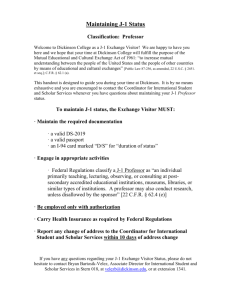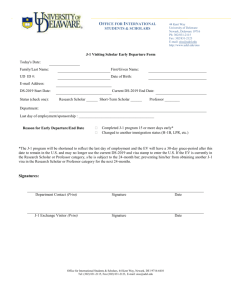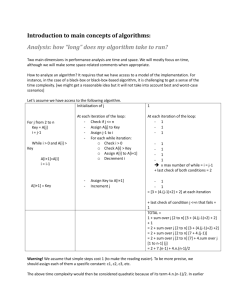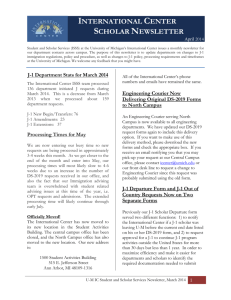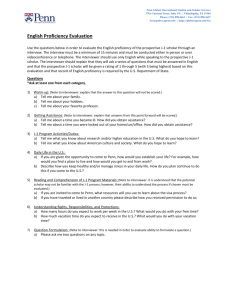Dynamic Programming Example: Assembly Line
advertisement
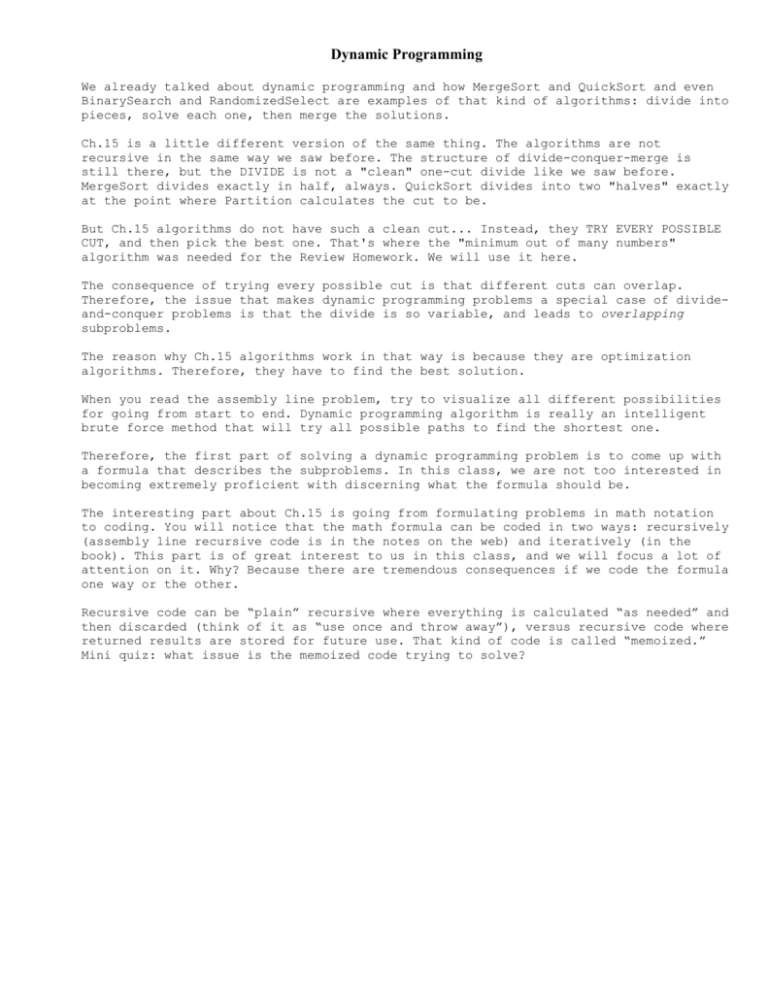
Dynamic Programming
We already talked about dynamic programming and how MergeSort and QuickSort and even
BinarySearch and RandomizedSelect are examples of that kind of algorithms: divide into
pieces, solve each one, then merge the solutions.
Ch.15 is a little different version of the same thing. The algorithms are not
recursive in the same way we saw before. The structure of divide-conquer-merge is
still there, but the DIVIDE is not a "clean" one-cut divide like we saw before.
MergeSort divides exactly in half, always. QuickSort divides into two "halves" exactly
at the point where Partition calculates the cut to be.
But Ch.15 algorithms do not have such a clean cut... Instead, they TRY EVERY POSSIBLE
CUT, and then pick the best one. That's where the "minimum out of many numbers"
algorithm was needed for the Review Homework. We will use it here.
The consequence of trying every possible cut is that different cuts can overlap.
Therefore, the issue that makes dynamic programming problems a special case of divideand-conquer problems is that the divide is so variable, and leads to overlapping
subproblems.
The reason why Ch.15 algorithms work in that way is because they are optimization
algorithms. Therefore, they have to find the best solution.
When you read the assembly line problem, try to visualize all different possibilities
for going from start to end. Dynamic programming algorithm is really an intelligent
brute force method that will try all possible paths to find the shortest one.
Therefore, the first part of solving a dynamic programming problem is to come up with
a formula that describes the subproblems. In this class, we are not too interested in
becoming extremely proficient with discerning what the formula should be.
The interesting part about Ch.15 is going from formulating problems in math notation
to coding. You will notice that the math formula can be coded in two ways: recursively
(assembly line recursive code is in the notes on the web) and iteratively (in the
book). This part is of great interest to us in this class, and we will focus a lot of
attention on it. Why? Because there are tremendous consequences if we code the formula
one way or the other.
Recursive code can be “plain” recursive where everything is calculated “as needed” and
then discarded (think of it as “use once and throw away”), versus recursive code where
returned results are stored for future use. That kind of code is called “memoized.”
Mini quiz: what issue is the memoized code trying to solve?
Dynamic Programming Example: Assembly Line
Goal: assembly a car as fast as possible, using two “identical” assembly lines, each with n machines.
a11
a12
a1,j-1
a1j
a1n
x1
e1
t21
chasis
t2,j-1
……….
……….
t11
e2
a21
ei: time to enter a line
xi: time to exit a line
car
t1,j-1
a22
a2,j-1
x2
a2n
a2j
i=1, 2
aij : time to process a job at station Sij
i=1, 2 j= 1, …, n
tik: time to transfer from line i after having gone through station Sik
f*: fastest time through the whole factory
f[i, j]: fastest time through station j on line i
i=1,2
i=1, 2 k= 1, …, n-1
j = 1, 2, …., n.
lineij: line whose station j-1 was used in a fastest way through Sij i=1, 2 j= 2, …, n
l*: line whose station n was used in the fastest way through the whole factory
Dynamic programming solution: decide beforehand how to split the problem into independent (and most
likely related and overlapping) optimal subproblems. Then solve the subproblems bottom-up, remembering
the intermediate solutions.
Steps:
1.
2.
3.
4.
Define the structure of the optimal solution
Write recursive formula describing the optimal solution
Compute the formula bottom-up
Construct the optimal solution from computed information
In the case of assembly line:
1. write the formula for the fastest way through station Sij
2. using formula from 1, write recursive formula to calculate the fastest time through the whole factory
3. write pseudocode to calculate the fastest time through factory is (e.g. 10 hours)
4. calculate the fastest route through the factory (e.g. for n=3, through stations S11, S12, and S23).
Greedy algorithm solution: at each decision point, make a choice that looks the best at the moment,
hoping that the final solution will be optimal. Solve the resulting subproblems top-down, and do not
remember them.
So, we have to write the algorithm to calculate the fastest time through the factory.
a[2][n]
t[2][n-1]
e[2]
x[2]
n
FastestTimeTruFactory
Calculate fastest time
through the entire factory
f*, l*,
list of stations in the shortest path (n long)
There are several ways in which we can write this algorithm. We can write it recursively top-down, or we
can write it iteratively bottom-up. It is usually easier to start recursively, because it matches the informal
human way of thinking.
Recursive call should return f*.
f* = min(f[1,n] + x1 , f[2,n] + x2 )
// we either come off line 1 or line 2
f[1, n] = min(f[1, n-1] + a1,n , f[2, n-1] + t2,n-1 + a1,n )
previous
// we either come directly from the
//station on line1, or we come from the
//previous station from line 2 and transfer
from //line 2 to line 1.
So we have to keep on “unwrapping” backwards. In general, we write a recursive function:
f[1, j] = min(f[1, j-1] + a1,j , f[2, j-1] + t2,j-1 + a1,j )
f[1,1] = e1 + a1,1
And call it with the initial call of f[1,n].
How to map math into code:
Calcf*(a,t,x,e,n) {
return min(Calcf(a,t,x,e,n, 1, n) + x[1],
}
Calcf(a,t,x,e,n, 2, n) + x[2])
Calcf(a,t,x,e,n, 1, j) {
If j==1
Return a[1][1]+e[1]
.
return min(Calcf(a,t,x,e,n, 1, j-1) + a[1][j], Calcf(a,t,x,e,n, 2, j-1) + t[2][j-1] + a[1][j])
}
Calcf* = min(CalcfWITHSTORAGE(…,1,n) +x[1] , CalcfWITHSTORAGE(…,2,n) + x[2])
CalfWITHSTORAGE(….) {
Check if we have it
If yes, return it
Else calculate, store, return
}
MainCalcWITHSTORAGE (…) {
Initialize f[ ][ ] to _____
}
CalfWITHSTORAGE() {
If f[ ] [ ] is not empty, we already have the solution
Return f[ ] [ ]
Else
If j==1
f[1,1] = a[1][1]+e[1]
Return f[1,1]
f[1,j-1] = . CalcfWITHSTORAGE(a,t,x,e,n, 1, j-1)
f[2, j-1] = CalcfWITHSTORAGE(a,t,x,e,n, 2, j-1)
return min(f[1, j-1] + a[1][j], f[2, j-1] + t[2][j-1] + a[1][j])
}
Then of course we have to write function Calcf(a, t, x, e,n, 2, j) which is a mirror image of
Calcf(a,t,x,e,n, 1, j).
BTW, It is also possible to write the algorithm using functions Calcf1(a, t, x, e,n, j) and Calcf2(a, t, x, e,n,
j).
So far so good; this code will return the fastest time through the factory, for example 5 hours. But we will
not know which stations to go though to achieve this fastest time. So, we have to modify the code to make
sure to remember which stations we passed through. Therefore, we cannot use the min function “out of the
box”, we have to write min from scratch and remember which side gave us the minimum.
//assume line[][] and l* are globals
Calcf*(a,t,x,e,n) {
if (Calcf(a,t,x,e,n, 1, n) + x[1] <= Calcf(a,t,x,e,n, 2, n) + x[2]) {
f* = Calcf(a,t,x,e,n, 1, n) + x[1]
l* = 1 // the car came off line 1
}
else {
f* = Calcf(a,t,x,e,n, 2, n) + x[2]
l* = 2 // the car came off line 2
}
return f*
}
Calcf(a,t,x,e,n, 1, j)
if (Calcf(a,t,x,e,n, 1, j-1) + a[1][j] <= Calcf(a,t,x,e,n, 2, j-1) + t[2][j-1] + a[1][j]) {
line[1, j] = 1
f[1,j] = Calcf(a,t,x,e,n, 1, j-1) + a[1][j]
}
else {
line[1, j] = 2
f[1,j] = Calcf(a,t,x,e,n, 2, j-1) + t[2][j-1] + a[1][j])
}
return f[1,j]
}
This code works, however it is going to be very slow, because it keeps on calculating the same quantities
over and over again. As soon as a quantity is calculated, it is discarded – we do not store it anywhere - so
when we need it the next time, we have to calculate it again.
A remedy for that is to save everything we calculate, and when we need it the next time, just pull it out of
the storage. This approach is called “memoized.” Memoized approach is the recursive approach with the
storage.
The algorithm is:
Initialize storage
Make the initial call
MemoizedCalcf( …, 1, j) {
if f[1,j] is not empty, return it
else calculate it recursively (watch out, the recursive call will be to MemoizedCalcf)
}
The third way is to calculate it iteratively, using bottom up approach. That code is in the book.
// Iterative version
//The fastest way through a factory with 2 assembly lines
// From the textbook, p.329
//Input:
//
matrices a and t; a is of size 2xn, t is of size 2xn-1.
//
vectors e and x, of size 2
//
integer n (number of stations)
//
//Output:
//
real number f*, the fastest time through the whole factory
//
integer l*, the line whose station was used to pass through nth station
//
matrix f[ , ] of size 2xn; or vectors f1[] and f2[] of size n, containing fastest times
through each station
//
matrix line[ , ] of size 2xn-1 or vectors line1[] and line2[] of size n-1, containing the
fastest path through each station
FASTEST-WAY(a, t, e, x, n) {
f1,1 = e1 + a1,1
//can be coded as: f[1,1] = e[1] + a[1,1]
//or:
f1[1] = e[1] + a[1,1]
f2,1 = e2 + a2,1
for j = 2, n
if ( f1,j-1 + a1,j ≤ f2,j-1 + t2,j-1 + a1,j )
//line 1 is faster
f1j = f1,j-1 + a1j
line1j = 1
//code as: line[1,j] or line1[j]
else
//line 2 is faster
f1,j = f2,j-1 + t2,j-1 + a1,j
line1,j = 2
if ( f2,j-1 + a2,j ≤ f1,j-1 + t1,j-1 + a2,j )
f2,j = f2,j-1 + a2,j
line2,j = 1
// line 2 is faster
else
//line 1 is faster
f2,j = f1,j-1 + t1,j-1 + a2,j
line2,j = 2
if (f1,n + x1 ≤ f2,n + x2 )
f* = f1,n + x1
l* = 1
else
f* = f2,n + x2
l* = 2
}
How do we know which stations are in the shortest path? Again, we have to use a recursive
approach.
l* tells what line was used for station n.
l[i,j] tells what line was used for station j-1 when getting to station j on line i.
So, we need:
l*
// this is line for station n
l[l*, n]
//this is line for station n-1
l[l[l*,n], n-1]
//this is line for station n-2
…
How do we read that from line[][] matrix?
l* tells us which line to read for station n-1, etc. keep on backtracking.
For example:
l*=2, n=3
line = NIL 2 2 //NIL means that line[1,1] and line[2,1] don’t exist
NIL 1 1
l*=2 means that we got off station S2,3
So we look up l[2,3] which is 1, which means we came through S1,2
So we look up l[1, 2], which is 2, which means we came through S2,1
So the shortest path through factory is S2,1 S1,2 S2,3
This is a very important approach that we will use for the majority of algorithms for the rest
of the semester.
PRINT-STATIONS(line, n) {
i = l*
print “line “ i “, station “ n
for (j = n, j ≥ 2, j—)
i = linei,j
print “line “ i “, station “ j-1
}
